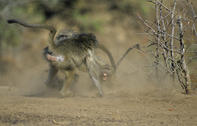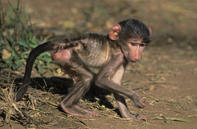What is Oligarchy?
The social system practised by baboons is known as an oligarchy. What this means is that baboons have a band of dominant males that work cooperatively to defend the females in the troop and they thus share the breeding resource.

Baboons do not have a harem system where only one male is dominant although there is a strict status hierarchy within the troop with young, prime individuals (usually the immigrants) being most aggressive and hence dominant. Males visually advertise their dominance by a display of their impressive canines.
For a young male baboon, rising up the ranks within his natal troop is extremely difficult. Young males will usually emigrate at six or seven years old (after puberty) and they will join another troop of baboons where they have no genetic ties.
These youngsters act aggressively and quickly rise in seniority. Males may move more than once until they find a troop where they stand the best chance of becoming dominant and hence winning access to females to breed.
Grooming and Godfathers

Living in a group has its disadvantages. Amongst a troop of baboons, there will be competition between individuals for food (or other social rights). The most dominant animals automatically get access to the best spots but by persuading more dominant individuals to form an alliance with it, a lowlier ranked baboon can enjoy first-class feeding sites and other privileges too.
Baboons build relationships through grooming. Within the troop, smaller sub-groups or cliques form through grooming. These individuals will usually sleep together, feed together and males (known as godfathers) will come to the rescue of the females that groom them (and their babies) should they be harassed by other baboons.
All males are dominant over females but there is a dominance hierarchy amongst females too and it’s particularly useful to have a male around to settle inter-female disputes. Females remain in the troop where they were born for life and they inherit the status of their mothers. This status does change temporarily depending on her reproductive condition with mothers with infant black babies being especially elevated in rank.
Baboon Childhood

When they are born, baby baboons are black with pink faces and ears.
The troop members are always fascinated by the small baboons and in many a social dispute may even attempt to use these infants as bargaining leverage by grabbing them. Understandably this creates mayhem amongst the troop and the godfathers perform an important role in protecting these youngsters from any kind of boisterous activity.
Godfathers have also been known to care for orphaned babies so long as they are older than six months and weaned. For the first five weeks of their lives, the babies cling to the mother’s belly where they have an on-tap supply of milk and can be transported safely whenever danger threatens.
At five weeks old, the babies can walk and at this stage, they begin to ride jockey on their mother’s backs using the kinked tail as a backrest.
By Megan Emmett